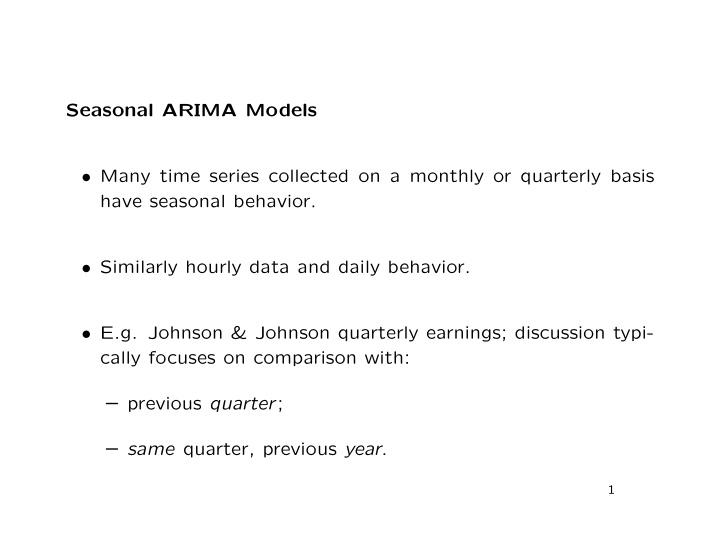



Seasonal ARIMA Models • Many time series collected on a monthly or quarterly basis have seasonal behavior. • Similarly hourly data and daily behavior. • E.g. Johnson & Johnson quarterly earnings; discussion typi- cally focuses on comparison with: – previous quarter ; – same quarter, previous year . 1
• That is, we compare x t with x t − 1 and x t − 4 . • More generally, we compare x t with x t − 1 and x t − s , where – s = 4 for quarterly data, – s = 12 for monthly data, – s = 24 for daily effects in hourly data, – s = 168 for weekly effects in hourly data, etc. • This suggests modeling x t in terms of x t − 1 and x t − s . 2
Pure Seasonal ARMA • The pure seasonal ARMA model has the form x t = Φ 1 x t − s + Φ 2 x t − 2 s + · · · + Φ P x t − Ps + w t + Θ 1 w t − s + Θ 2 w t − 2 s + · · · + Θ Q w t − Qs . • Notation: ARMA( P, Q ) s . • In operator form: Φ P ( B s ) x t = Θ Q ( B s ) w t . • Φ P ( B s ) and Θ Q ( B s ) are seasonal autoregressive and moving average operators. 3
Multiplicative Seasonal ARMA • ACF of pure seasonal ARMA is nonzero only at lags s , 2 s , . . . ; most seasonal time series have other nonzero values. • For such series, w ( s ) = Θ Q ( B s ) − 1 Φ P ( B s ) x t is not white noise t for any choice of Φ P and Θ Q . • But suppose that for some Φ P and Θ Q , w ( s ) is ARMA( p, q ): t φ p ( B ) w ( s ) = θ q ( B ) w t , t where { w t } is white noise. 4
• Then x t satisfies Φ P ( B s ) φ p ( B ) x t = Θ Q ( B s ) θ q ( B ) w t . • This is the Multiplicative Seasonal ARMA model ARMA( p, q ) × ( P, Q ) s . • The non-seasonal parts φ p and θ q control short-term corre- lations (up to half a season, lag ≈ s/ 2), while the seasonal parts Φ P and Θ Q control the decay of the correlations over multiple seasons. 5
Example: Johnson & Johnson earnings; R analysis par(mfrow = c(2, 1)) plot(log(jj)) jjl = lm(log(jj) ~ time(jj) + factor(cycle(jj))) summary(aov(jjl)) jjf = ts(fitted(jjl), start = start(jj), frequency = frequency(jj)) lines(jjf, col = 2, lty = 2) jjr = ts(residuals(jjl), start = start(jj), frequency = frequency(jj)) plot(jjr) acf(jjr) pacf(jjr) 6
• PACF is simpler than ACF: – ACF spikes at lags 4, 8, perhaps 12; of these, PACF spikes only at lag 4; – apart from lags 4, 8, . . . , PACF drops off faster. • (P)ACF indicates neither simple ARMA nor simple ARMA 4 . • PACF suggests ARMA(2 , 0) × (1 , 0) 4 : jja = arima(jjr, order = c(2, 0, 0), seasonal = list(order = c(1, 0, 0), period = 4)) print(jja) tsdiag(jja) 7
• Note: the original fit of the straight line and seasonal dum- mies was by OLS; – possibly inefficient; – invalid inferences (standard errors, etc.). • Solution: refit as part of the time series model. x = model.matrix( ~ time(jj) + factor(cycle(jj))) jja = arima(log(jj), order = c(2, 0, 0), seasonal = list(order = c(1, 0, 0), period = 4), xreg = x, include.mean = FALSE) print(jja) tsdiag(jja) 8
Notes: • The time series being fitted is the original unadjusted log(jj) . • The regressors are specified as the matrix argument xreg . • arima does not check for linear dependence, so we must either omit one dummy variable from xreg or use include.mean = FALSE in arima . • Regression parameter estimates are similar to OLS, but stan- dard errors are roughly doubled . • Using SAS: proc arima program and output. 9
Multiplicative Seasonal ARIMA • The seasonal difference operator is ∇ s = 1 − B s . • Some series show slow decay of ACF only at lags s, 2 s, . . . , which suggests seasonal differencing. – But note: seasonal means also give slow decay of ACF at those lags. • The Multiplicative Seasonal ARIMA model ARIMA( p, d, q ) × ( P, D, Q ) s is Φ P ( B s ) φ p ( B ) ∇ D s ∇ d x t = Θ Q ( B s ) θ q ( B ) w t . 10
Recommend
More recommend